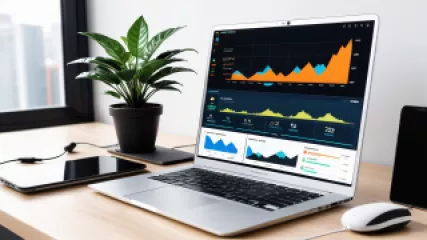Digital Wellbeing: What Are the Best Digital Wellness Tools?
Digital Wellbeing: What Are the Best Digital Wellness Tools?
In today's digital-driven world, maintaining a healthy relationship with technology has become increasingly crucial for our overall well-being. As we navigate the ever-expanding landscape of digital tools and platforms, it's essential to find the right balance between using technology to enhance our lives and preventing it from becoming a source of stress, distraction, and burnout. In this article, we'll explore the concept of digital wellbeing and delve into some of the best digital wellness tools that can help us cultivate a healthier, more mindful approach to technology.
Understanding Digital Wellbeing
Digital wellbeing refers to the practice of using digital technologies in a way that supports our physical, mental, and emotional health. It encompasses a range of strategies and practices aimed at helping us manage our digital lives, reduce the negative impact of technology on our well-being, and foster a more intentional and balanced relationship with the digital world.
In today's fast-paced, technology-driven society, it's easy to become overwhelmed by the constant stream of notifications, the pressure to be constantly connected, and the temptation to endlessly scroll through social media. This can lead to a range of issues, such as increased stress, anxiety, sleep disruption, and a decline in productivity and focus.
By adopting a digital wellbeing mindset and utilizing the right tools, we can reclaim control over our digital lives, reduce the negative impact of technology, and cultivate a more positive and fulfilling relationship with the digital world.
The Benefits of Digital Wellbeing
Embracing digital wellbeing can bring about numerous benefits, both in our personal and professional lives. Some of the key advantages of practicing digital wellbeing include:
- Improved mental health: By reducing digital distractions and setting healthy boundaries around technology use, we can experience lower levels of stress, anxiety, and burnout, leading to better overall mental well-being.
- Enhanced productivity and focus: Digital wellness tools can help us minimize interruptions, stay on task, and increase our ability to concentrate, resulting in greater productivity and a more efficient use of our time.
- Better work-life balance: Implementing digital wellness practices can help us create a healthier separation between our professional and personal lives, allowing us to be more present and engaged in each domain.
- Increased mindfulness and self-awareness: Many digital wellness tools encourage us to be more mindful of our technology use, leading to greater self-awareness and the ability to make more conscious choices about how we engage with digital platforms.
- Improved physical health: By reducing sedentary time, promoting healthy habits, and encouraging physical activity, digital wellness tools can contribute to better overall physical health and well-being.
By embracing digital wellbeing, we can not only improve our individual well-being but also contribute to a more sustainable and healthy digital ecosystem, where technology is used as a tool to enhance our lives rather than control them.
The Best Digital Wellness Tools
To help you on your digital wellbeing journey, we've compiled a list of some of the best digital wellness tools available. These tools cover a wide range of features and functionalities, catering to different needs and preferences. Let's explore them in more detail:
1. Screen Time and App Limits
One of the fundamental aspects of digital wellbeing is being aware of and managing our screen time and app usage. Several operating systems, such as iOS and Android, offer built-in screen time and app limit features that allow us to track our device usage, set time limits for specific apps, and schedule downtime or "do not disturb" periods.
These features can be particularly helpful in curbing mindless scrolling, reducing distractions, and ensuring that we're not spending too much time on our devices. By setting reasonable limits and being mindful of our digital habits, we can regain control over our technology use and create a healthier balance in our lives.
2. Mindfulness and Meditation Apps
Integrating mindfulness and meditation practices into our digital lives can be a powerful way to reduce stress, improve focus, and cultivate a greater sense of inner calm. Apps like Calm, Headspace, and Insight Timer offer a wide range of guided meditations, mindfulness exercises, and sleep-focused content to help us better manage our mental and emotional well-being.
These apps can be particularly useful in counterbalancing the constant stimulation and distractions of the digital world, allowing us to take regular breaks for self-reflection and inner exploration.
3. Digital Detox and Distraction-Blocking Tools
Sometimes, we need more than just app limits and scheduled downtime to truly disconnect and recharge. That's where digital detox tools come into play. Apps like Forest, Freedom, and AppBlock can help us temporarily block access to distracting websites and apps, encouraging us to focus on the task at hand or engage in more mindful activities.
These tools can be particularly useful for deep work, studying, or simply taking a break from the constant digital stimulation. By removing the temptation to check our devices, we can cultivate a greater sense of presence and intentionality in our daily lives.
4. Productivity and Time Management Apps
Maintaining productivity and effective time management is crucial for our overall well-being, especially in the digital age. Apps like Pomodoro Technique, Todoist, and Trello can help us organize our tasks, prioritize our work, and optimize our time usage.
These tools can assist us in minimizing distractions, improving focus, and ensuring that we're allocating our time and energy towards the most important and meaningful tasks. By enhancing our productivity, we can reduce stress, increase job satisfaction, and free up more time for rest, leisure, and personal growth.
5. Digital Wellbeing Dashboards and Insights
Some digital wellness tools go beyond simply tracking and limiting our screen time, offering comprehensive dashboards and insights to help us better understand our digital habits and patterns.
Apps like Google Digital Wellbeing, Apple Screen Time, and Microsoft MyAnalytics provide detailed reports on our device usage, app engagement, and even email and meeting habits. These insights can be invaluable in identifying areas for improvement, setting meaningful goals, and making more informed decisions about our technology use.
By gaining a deeper understanding of our digital lives, we can make more conscious and intentional choices that align with our values and support our overall well-being.
6. Offline Activities and Digital-Free Spaces
While digital wellness tools can be incredibly helpful, it's also important to incorporate offline activities and create digital-free spaces in our lives. This can include setting aside dedicated times for unplugging, engaging in physical exercise, reading books, or simply spending quality time with loved ones without the presence of digital devices.
By intentionally carving out these offline moments, we can reduce our reliance on technology, recharge our mental and physical batteries, and cultivate a more balanced and fulfilling lifestyle.
7. Digital Wellness Education and Resources
Lastly, it's essential to continuously educate ourselves on the best practices and strategies for digital wellbeing. Exploring resources like online articles, podcasts, workshops, and virtual communities can help us stay informed, gain new insights, and share experiences with others on similar journeys.
By actively seeking out digital wellness education and resources, we can deepen our understanding of the complex relationship between technology and our well-being, and find innovative ways to integrate healthy digital habits into our daily lives.
Conclusion
As we navigate the ever-evolving digital landscape, embracing digital wellbeing has become a crucial aspect of maintaining a healthy and balanced lifestyle. By leveraging the right digital wellness tools, we can reclaim control over our digital lives, reduce the negative impact of technology, and cultivate a more intentional and fulfilling relationship with the digital world.
Remember, the journey towards digital wellbeing is not a one-size-fits-all approach. Each of us has unique needs, preferences, and challenges when it comes to technology use. Experiment with different tools and strategies, and find what works best for you. Ultimately, the goal is to create a digital environment that supports your overall well-being, enhances your productivity, and allows you to thrive in the digital age.
In summary, the best digital wellness tools to consider include:
- Screen time and app limit features
- Mindfulness and meditation apps
- Digital detox and distraction-blocking tools
- Productivity and time management apps
- Digital wellbeing dashboards and insights
- Offline activities and digital-free spaces
- Digital wellness education and resources
By incorporating these tools and practices into your daily life, you can take meaningful steps towards achieving a healthier, more balanced, and fulfilling relationship with technology. Embrace the power of digital wellbeing and unlock the full potential of the digital world while safeguarding your overall well-being.
About the Author
Russ Moore is a digital wellness expert and the founder of the Digital Wellbeing Institute, a non-profit organization dedicated to promoting healthy technology use and digital mindfulness. He has been featured in various publications and podcasts, sharing his insights on the intersection of technology, mental health, and personal growth.






